Asus GeForce GTX 950 Strix Review
Today we get our first look at Nvidia's latest GPU in Asus' GeForce GTX 950 Strix.
Why you can trust Tom's Hardware
Game Tests
Battlefield 4
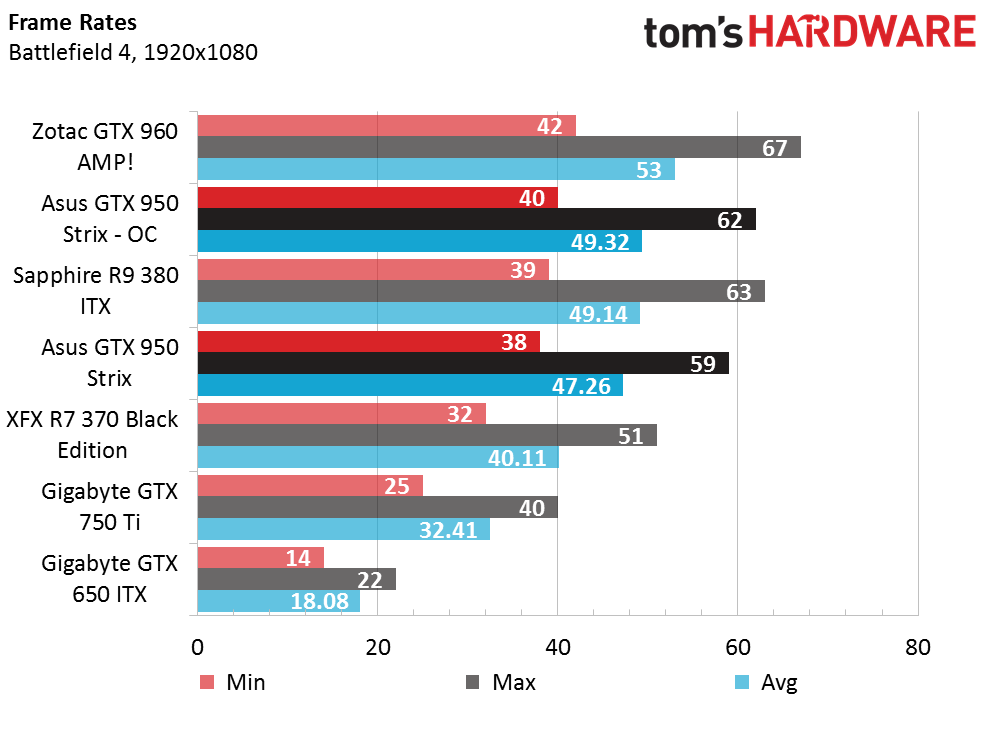
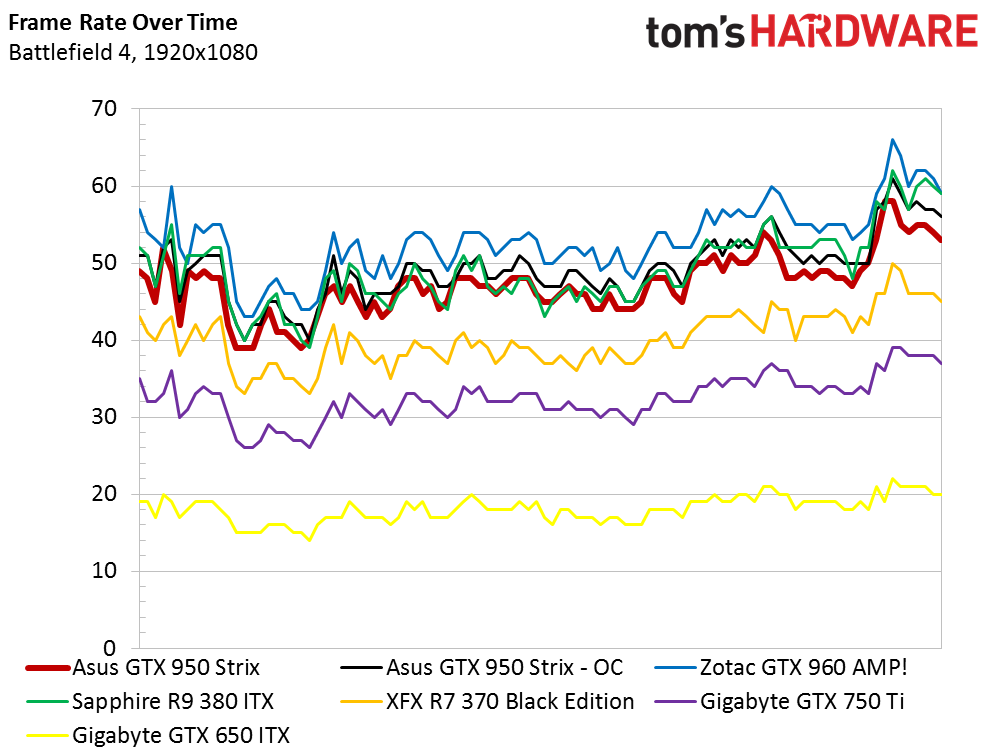
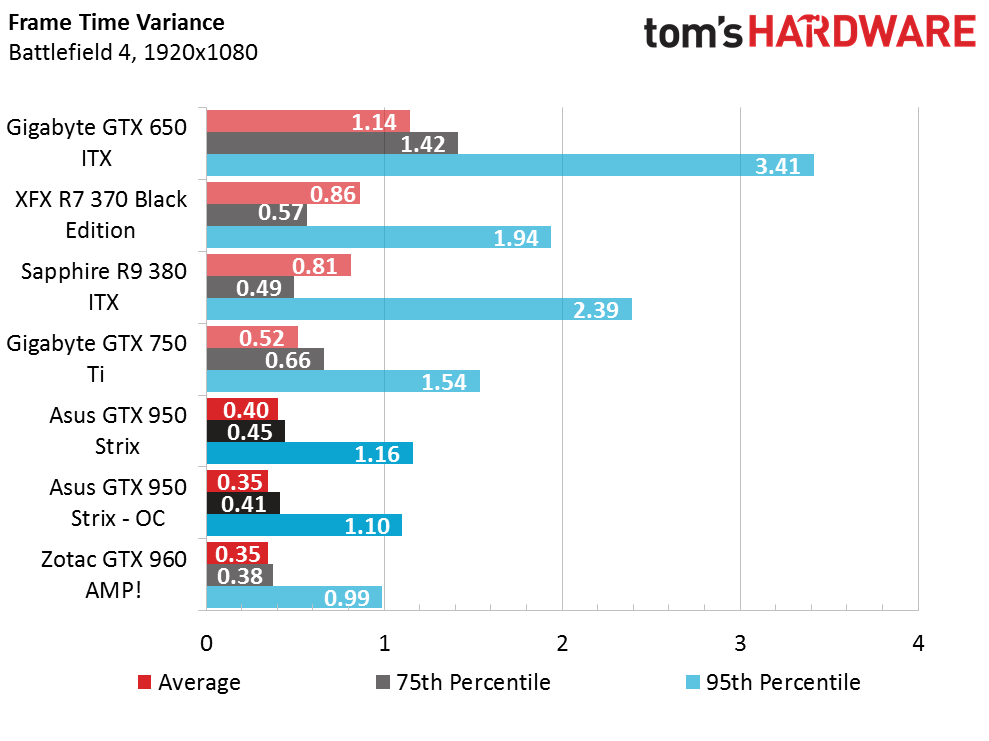
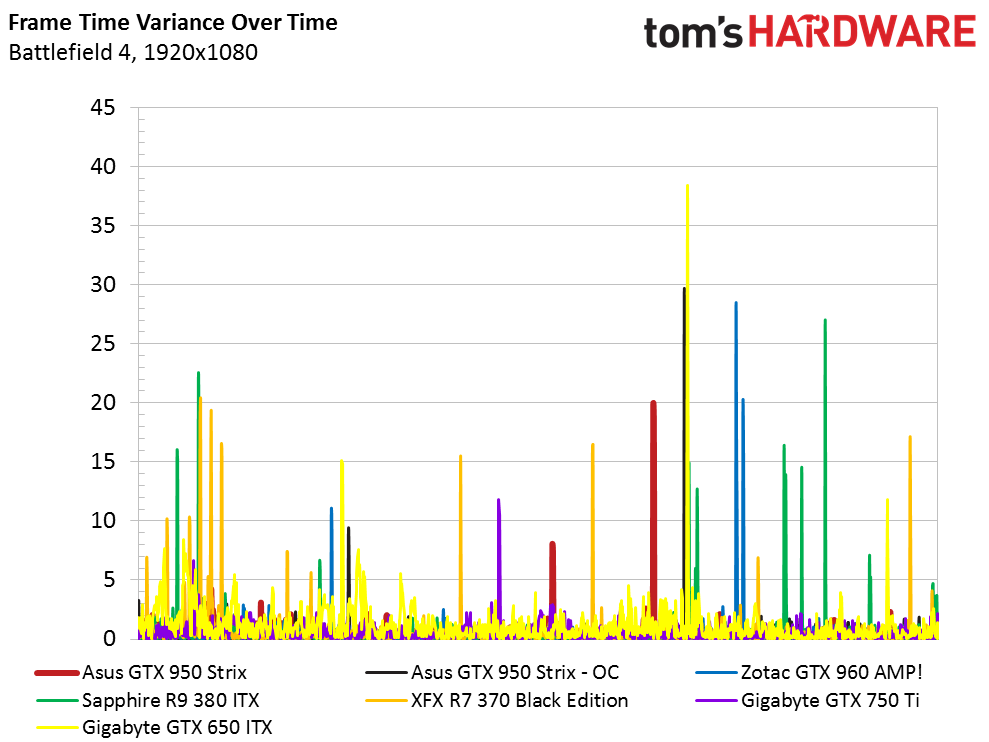
The first test I ran was Battlefield 4 at 1080p. Before graphing the results, it wasn’t immediately apparent just how well Asus’ GeForce GTX 950 performed. At this resolution, the 950 easily outperforms its competition and even nips the heels of Nvidia’s higher-tier GPU.
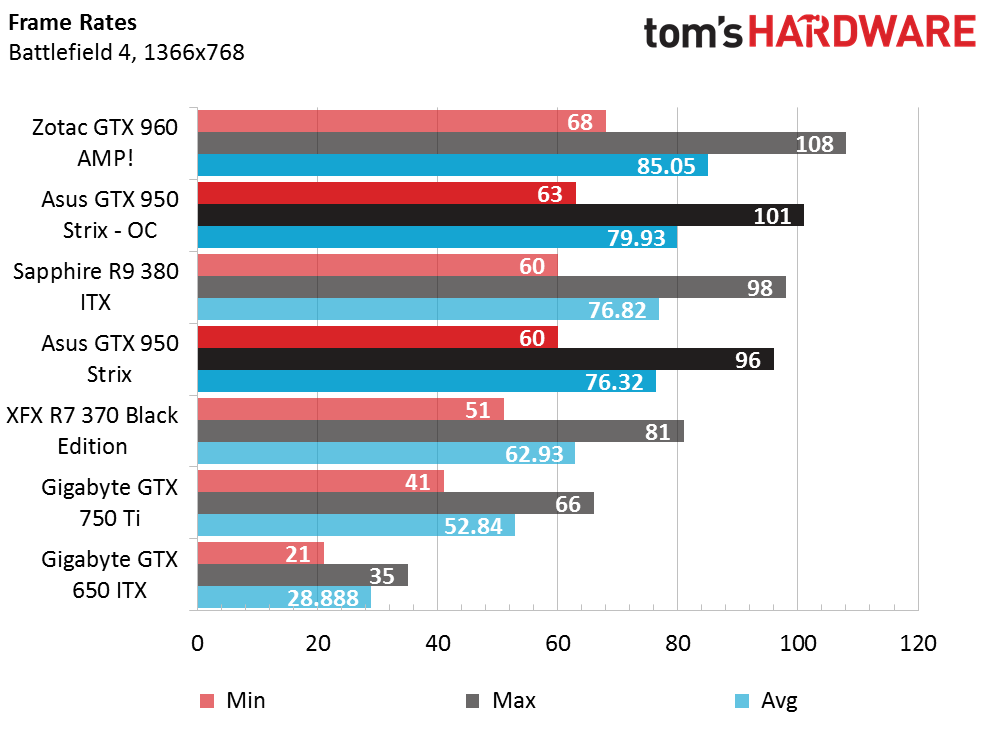
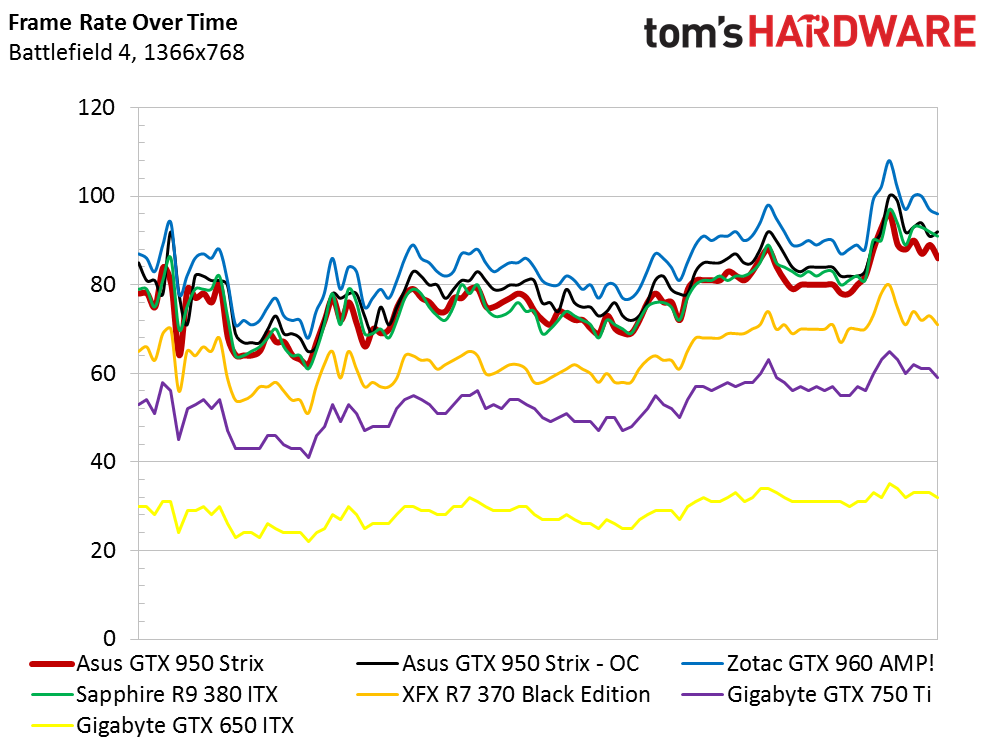
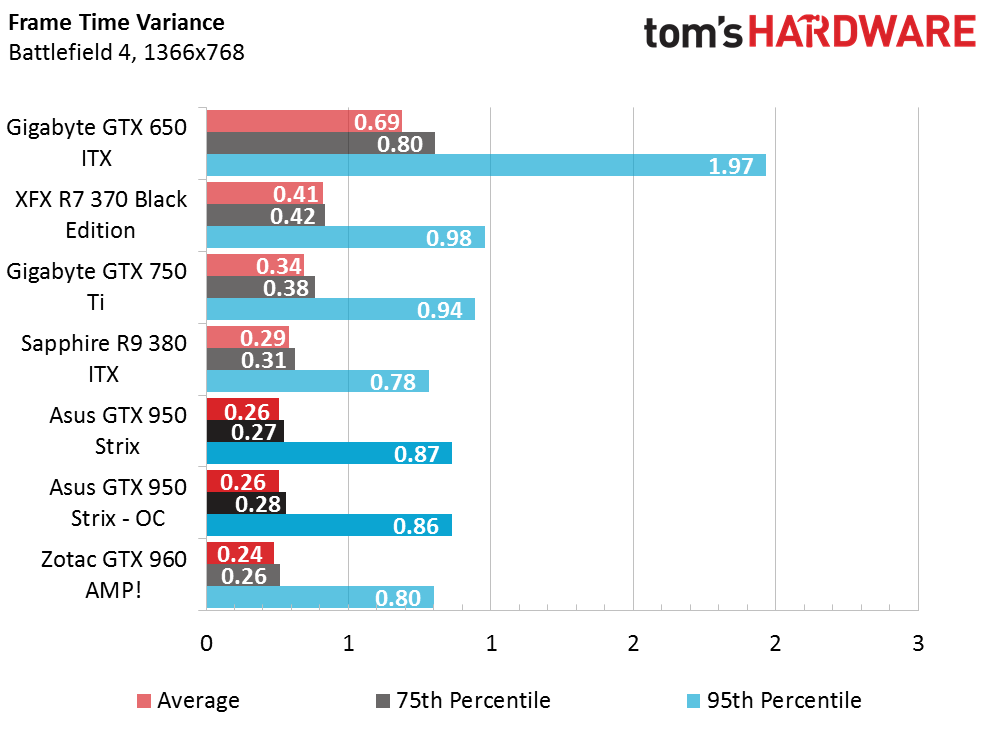
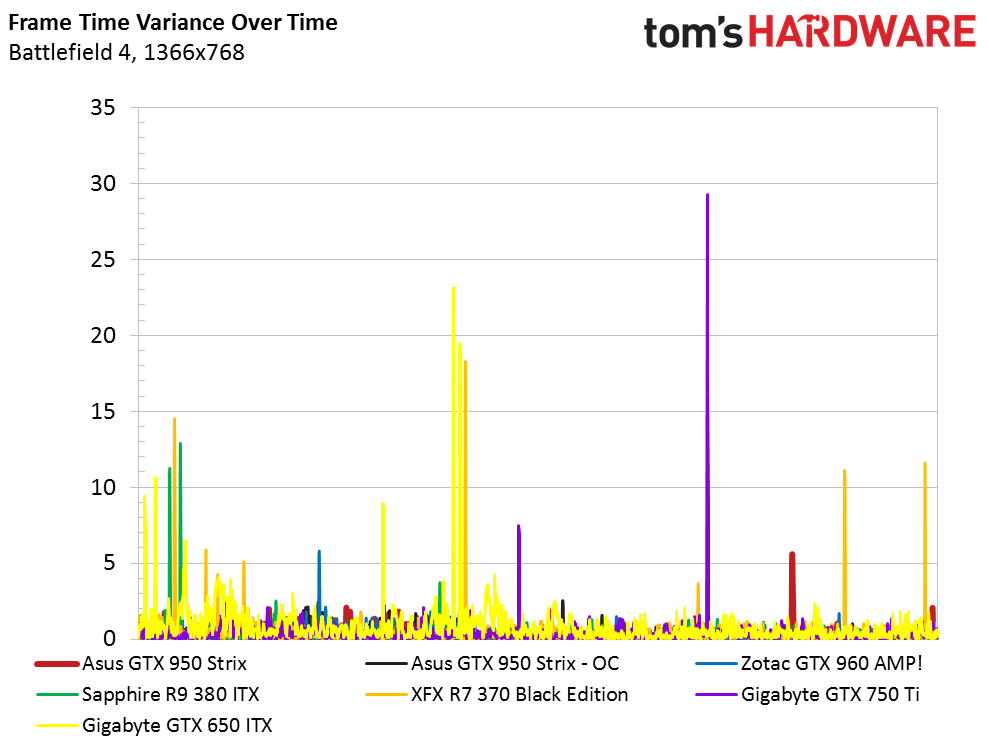
In Battlefield 4, Asus’ GTX 950 Strix offers an amazing experience running on a lower-res display. At no point did the frame rate dip below 60, all while running the highest available detail settings. AMD’s R7 370 just can’t keep up, and even the higher-end R9 380 delivers similar performance.
Far Cry 4
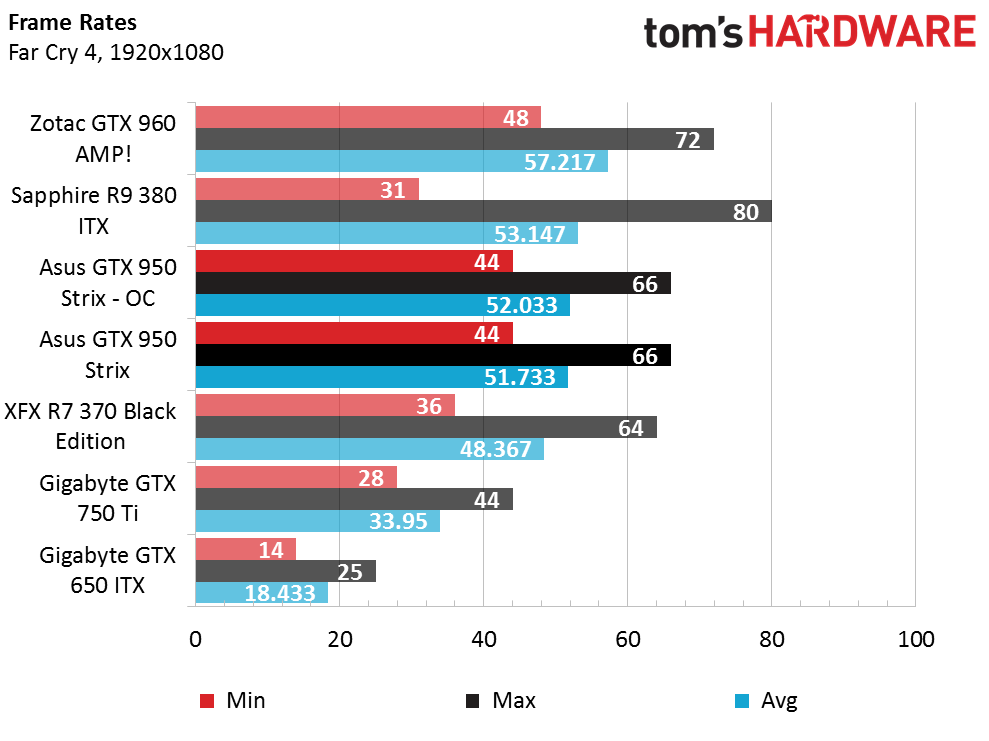
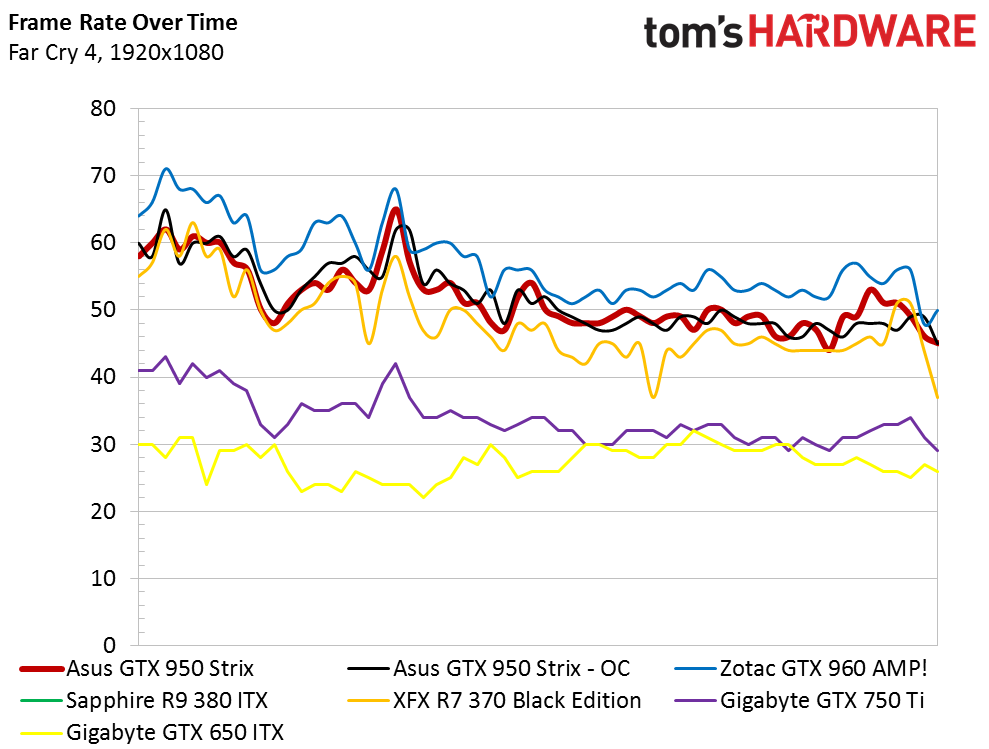
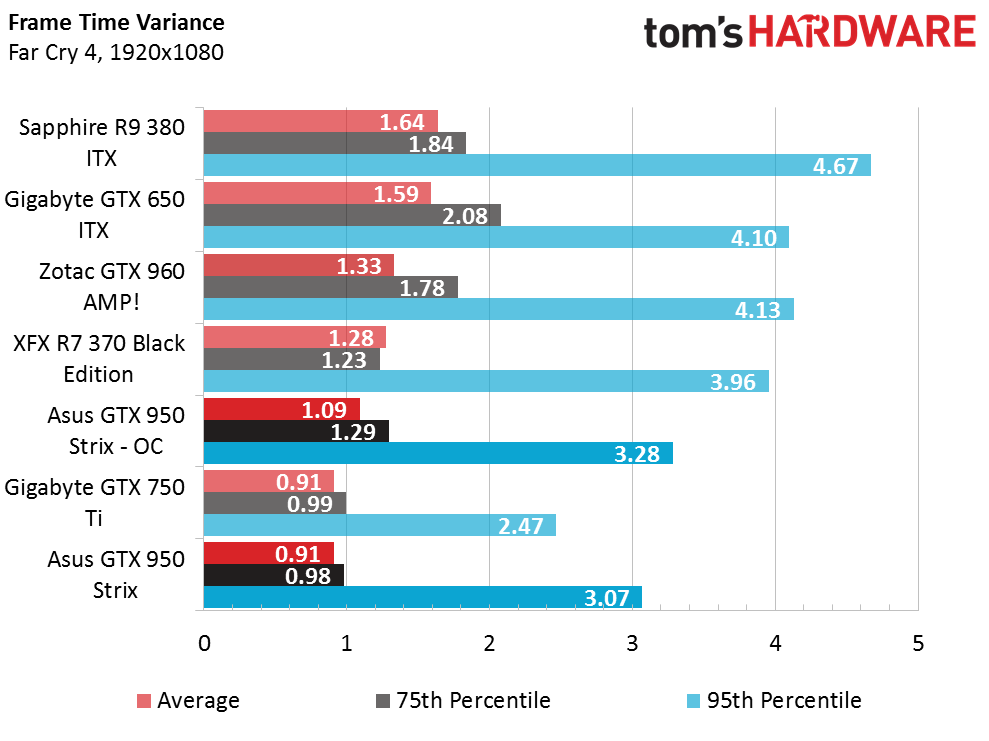
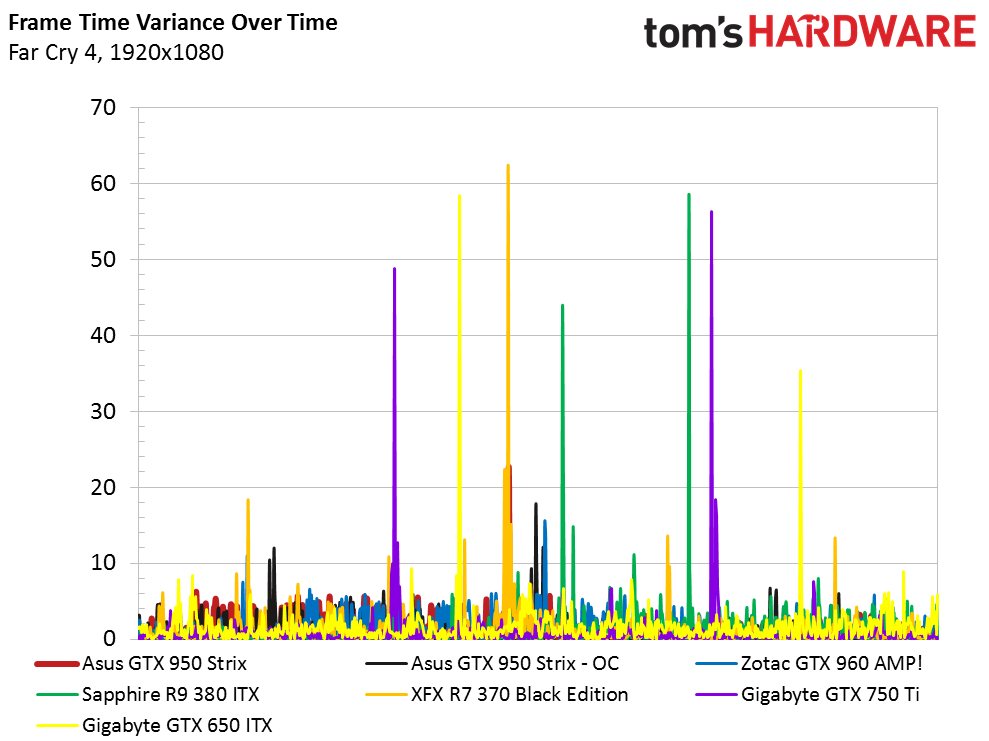
Far Cry 4 was tested next. It's one of the more demanding titles available today, and it is also one of the easiest to notice dips in performance. At 1080p, the GTX 950 Strix manages good performance, and again trails the more expensive 960 closely. The game remains fairly smooth, maintaining frame rates above 40. The R9 380, which we tested twice to be sure, isn't nearly as enjoyable. It often dipped into the low 30s.
You’d probably want to lower the settings a little bit for smoother game play, but you can easily get away with leaving the graphics maxed out like this.
Dropping the resolution to 1366x768 has predictable results. With maxed-out graphics settings, the GTX 950 Strix is able to keep the frame rate above 60 at all times, generally landing in the 80 FPS range.
Grand Theft Auto V
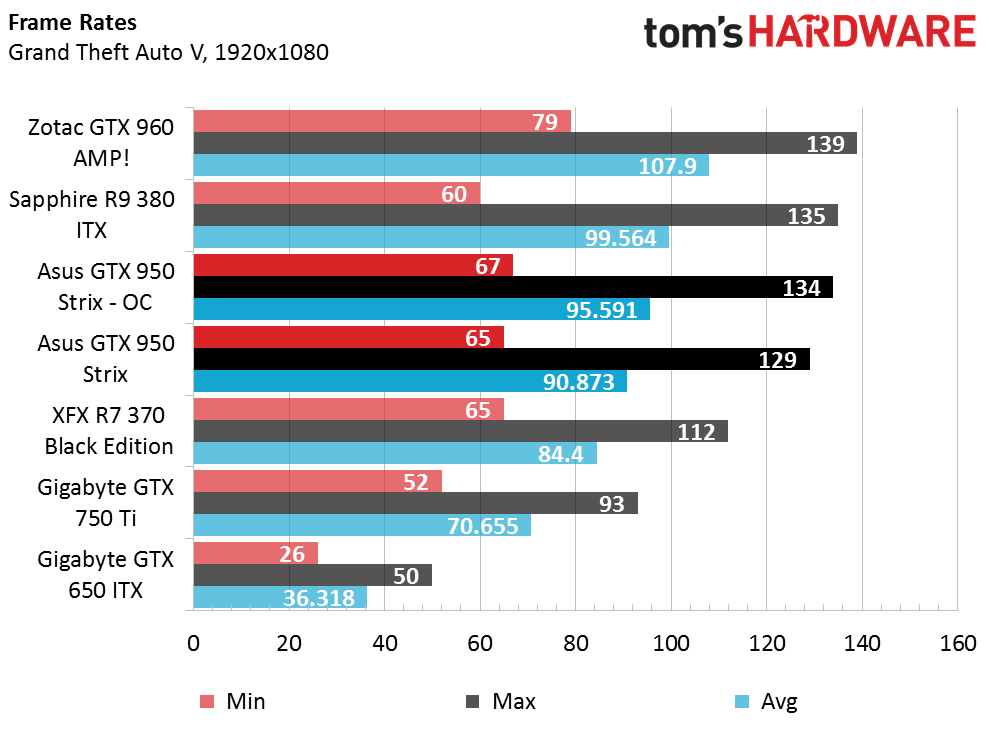
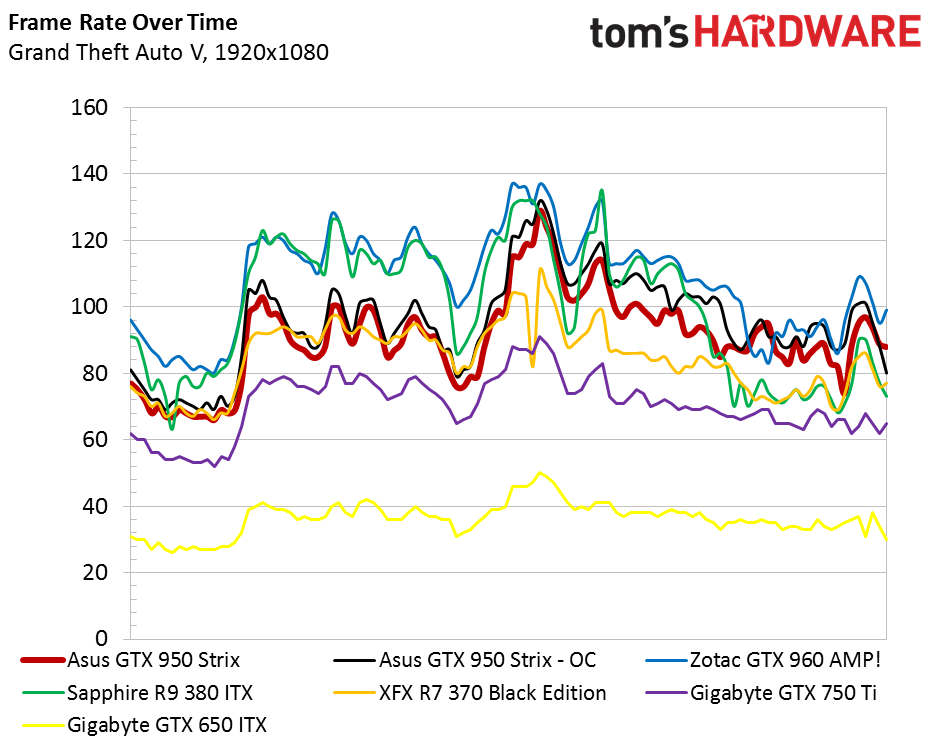
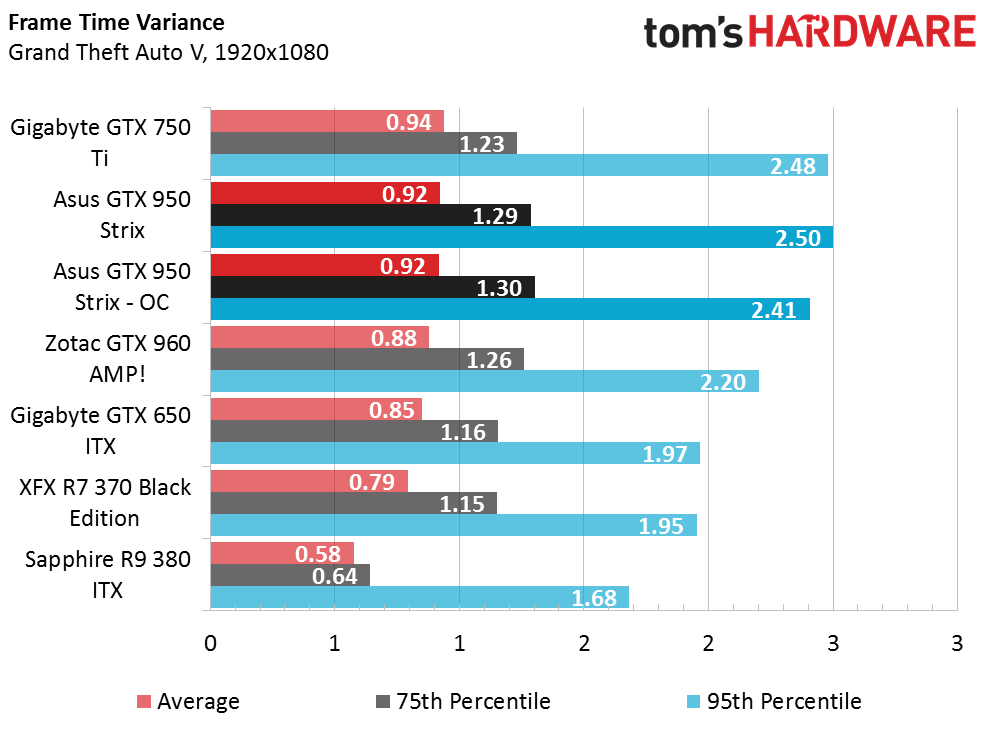
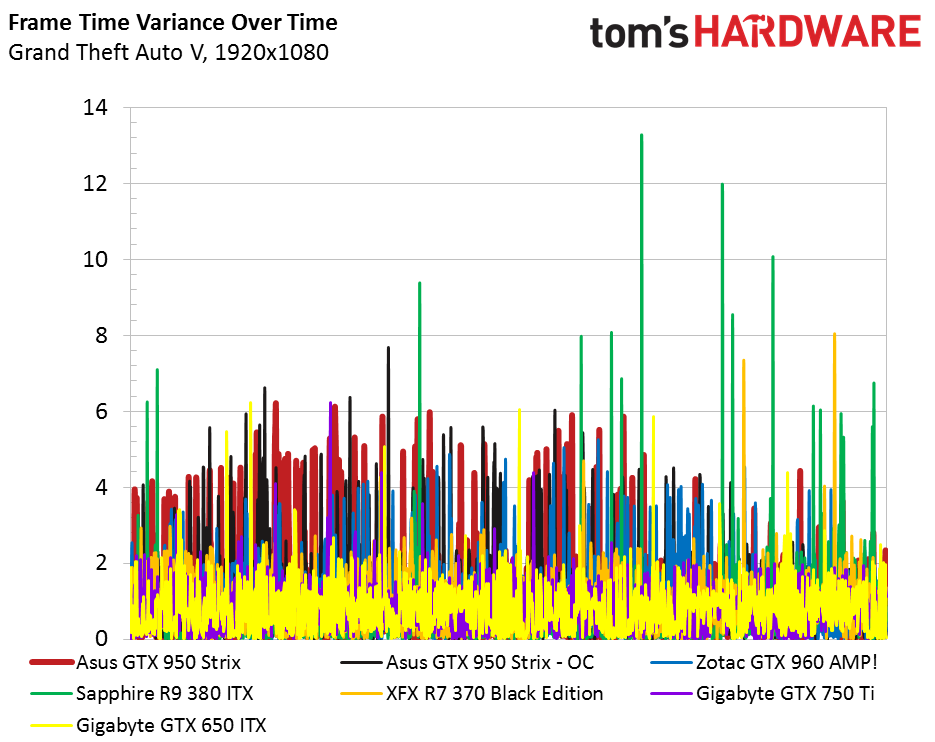
For the Grand Theft Auto V tests, I decided to lower the graphics settings somewhat. Even though the in-game slider bar isn't particularly precise, it was clear that our settings were going to blow past the GTX 950's available 2GB.
The average frame rate ended up in the 90s. The GTX 750 Ti was left in the dust again, but AMD’s R7 370 proved to be more competitive in this game. A GeForce GTX 960 delivers a decent advantage over the 950 in Grand Theft Auto V, too.
Get Tom's Hardware's best news and in-depth reviews, straight to your inbox.
If you are gaming at 1366x768, you’ll want to boost the settings higher than I had them. The game was running at easily double the average refresh rate of a monitor that size. Interestingly, the GTX 750 Ti offered similar performance at these settings.
Metro: Last Light
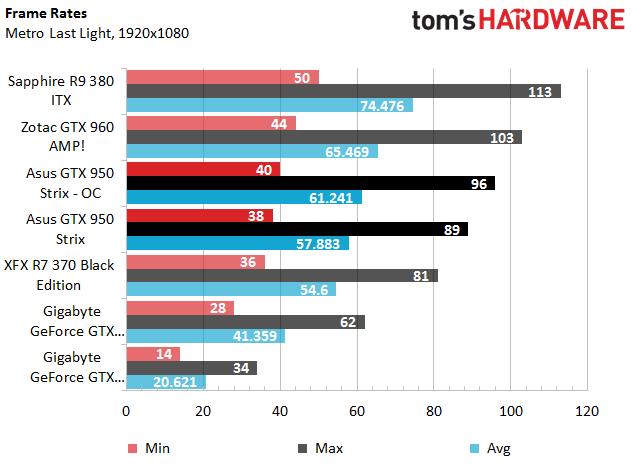
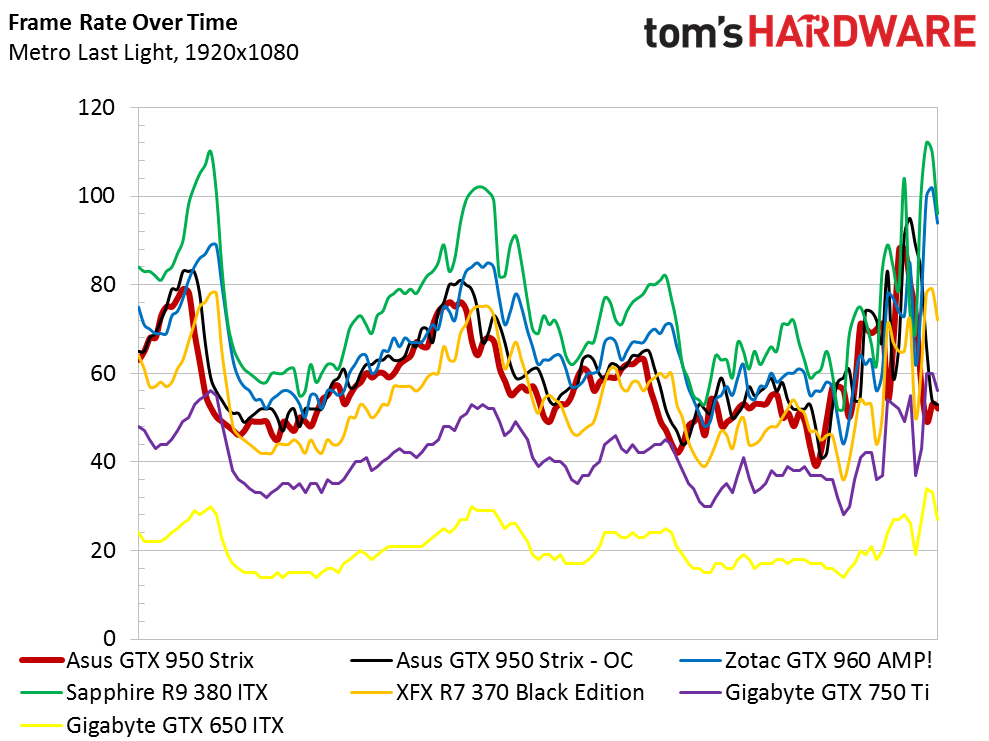
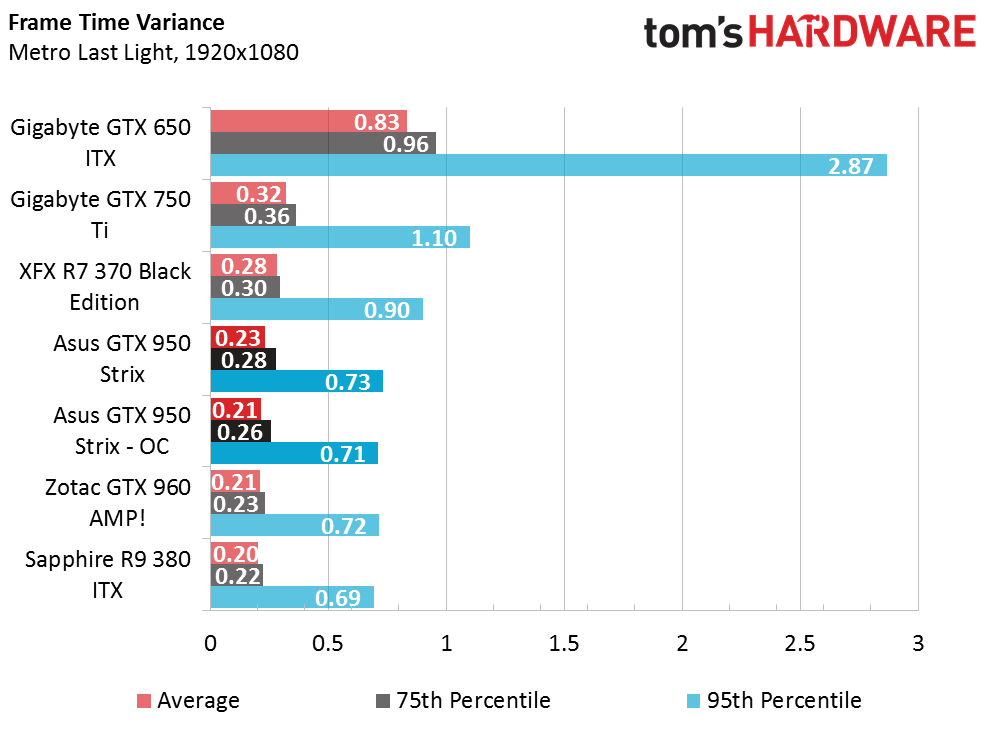
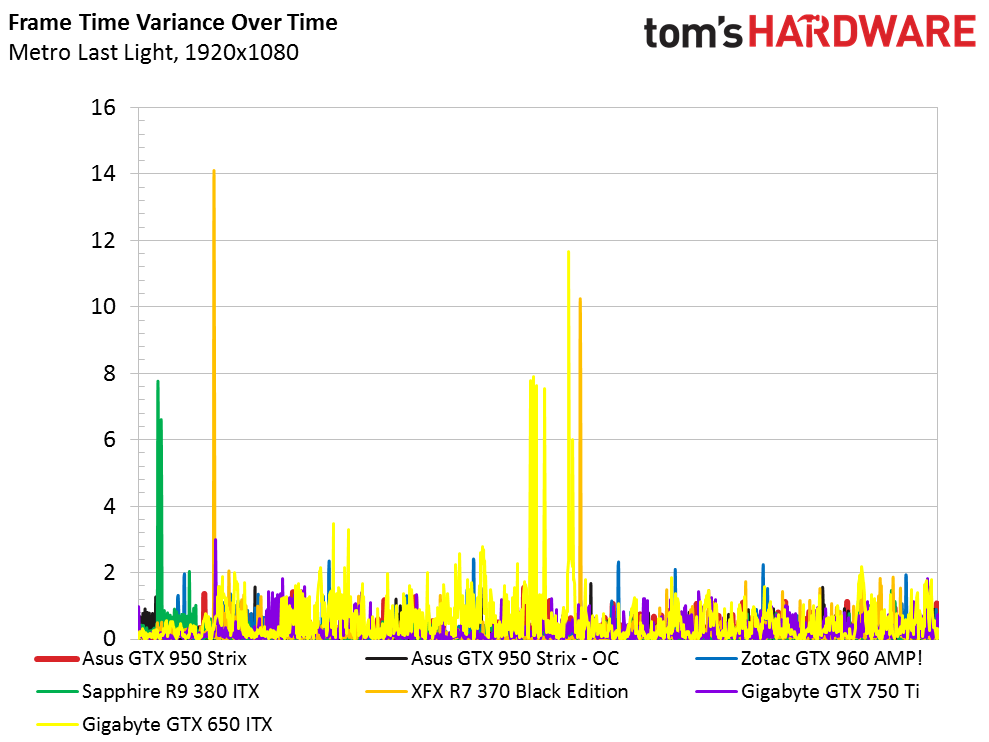
Asus’ GTX 950 Strix maintains an average frame rate around 60 FPS. It dips as low as 38, which is too low for many gamers, so dropping the settings slightly in Metro: Last Light would likely be a favorable decision. To be fair, owning a GeForce GTX 960 wouldn’t change the situation; you'd still need to relax the detail preset. An R7 370 offers a similar level of performance in this game.
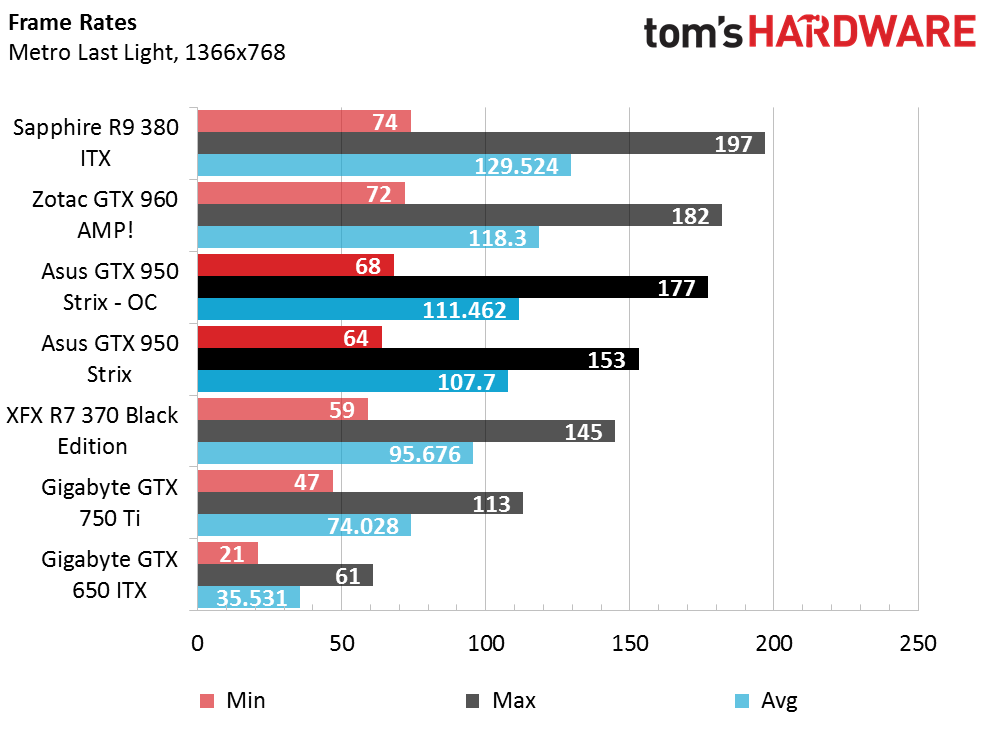
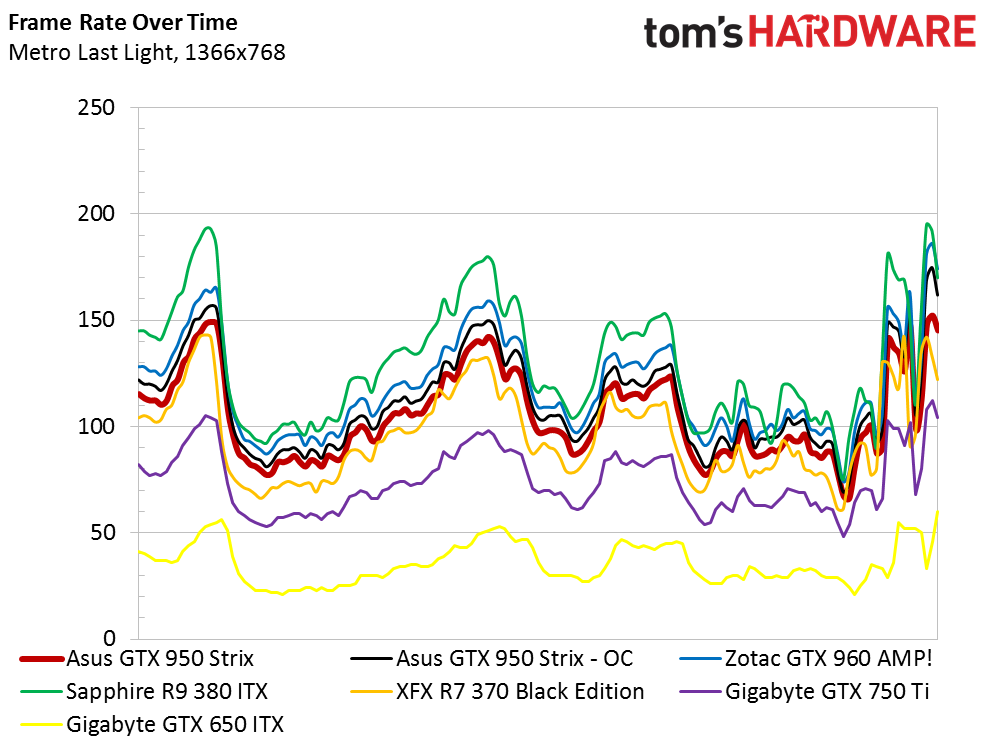
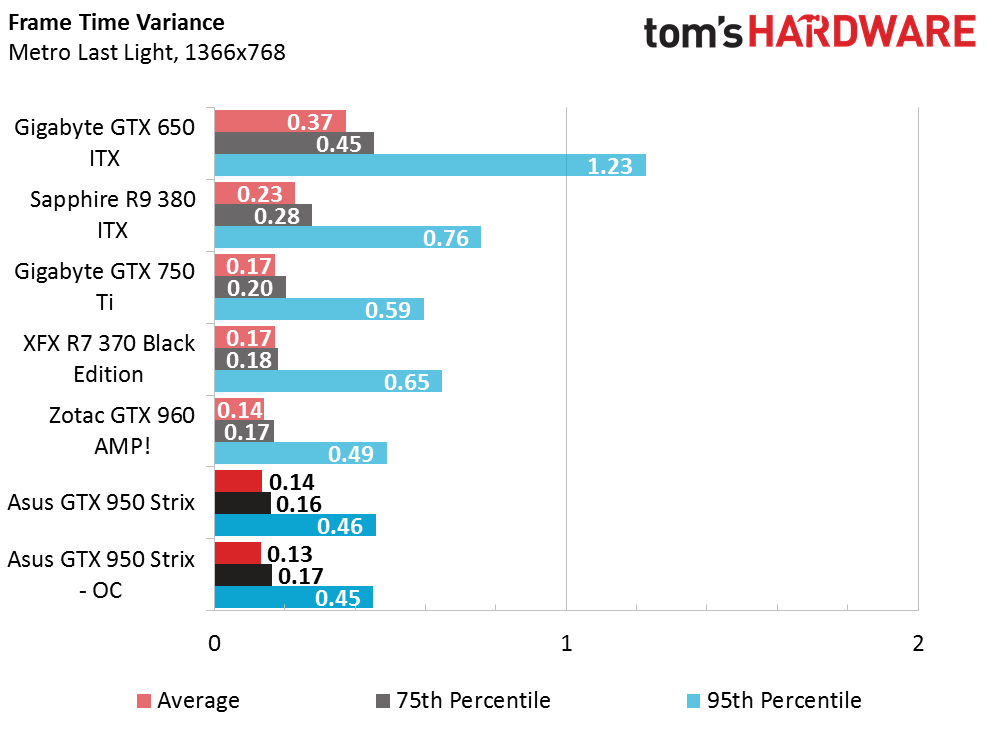
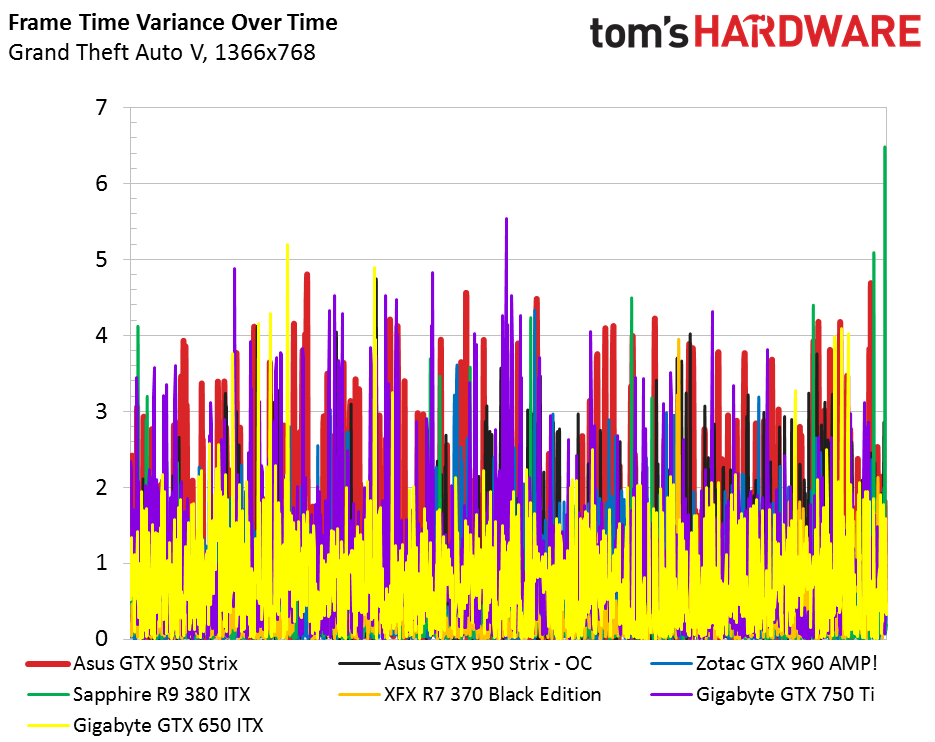
For gamers running lower-resolution panels, an Asus GTX 950 Strix offers excellent performance. With graphics quality maxed out, Metro: Last Light never dipped below 60 FPS. Meanwhile, a GeForce GTX 650 has no hope of running the game smoothly, making a GTX 950 a major upgrade.
Middle Earth: Shadow of Mordor
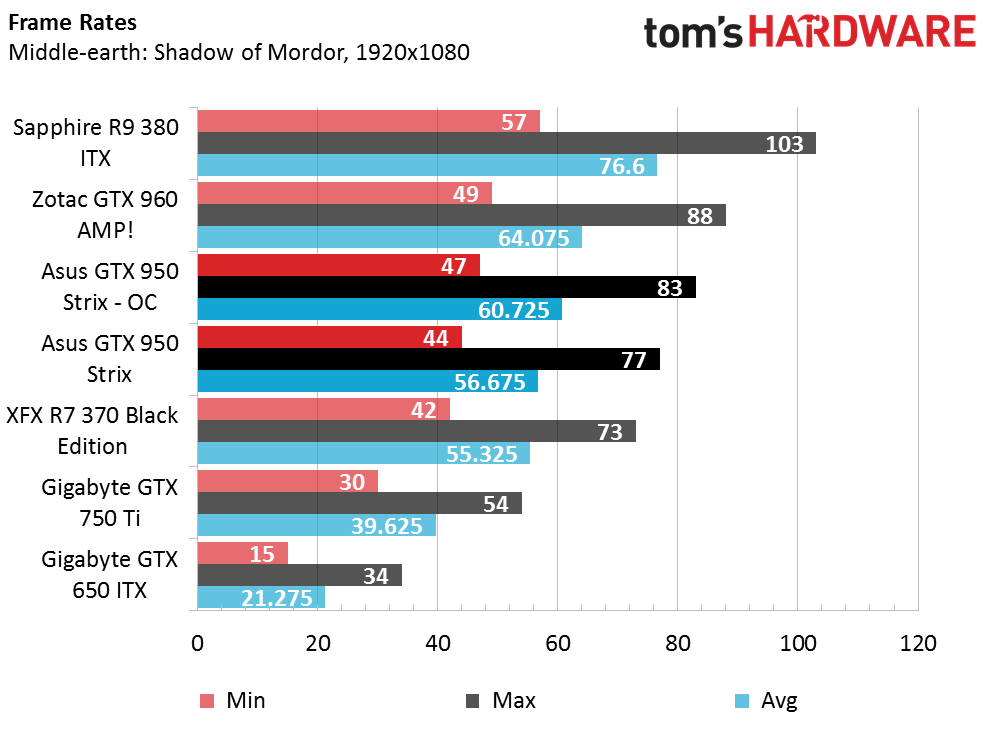
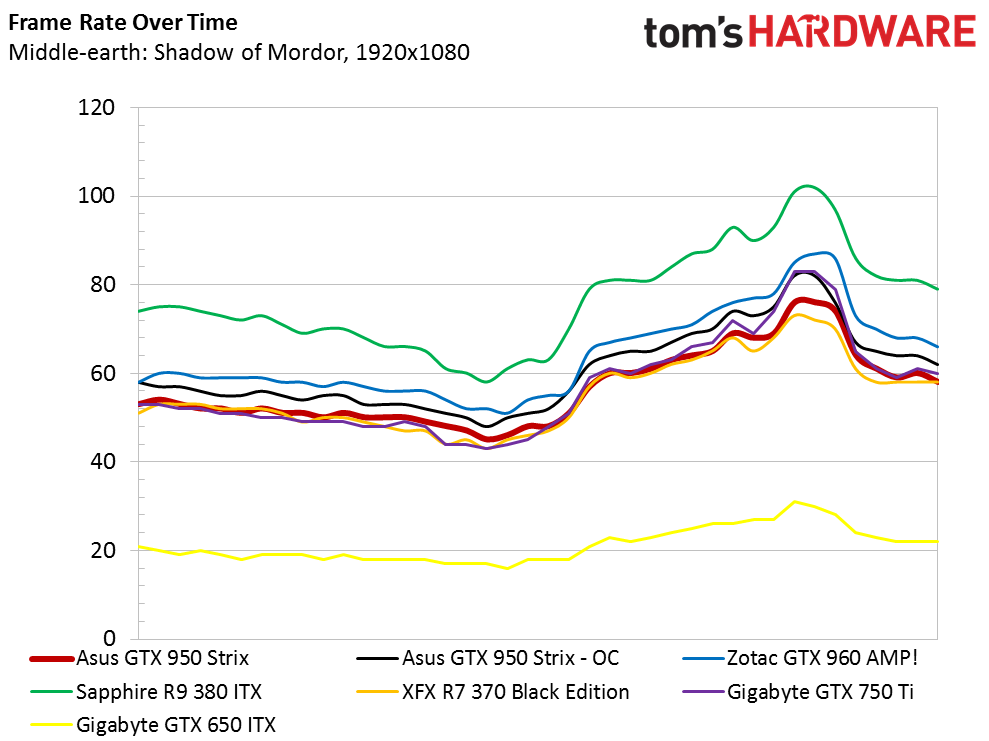
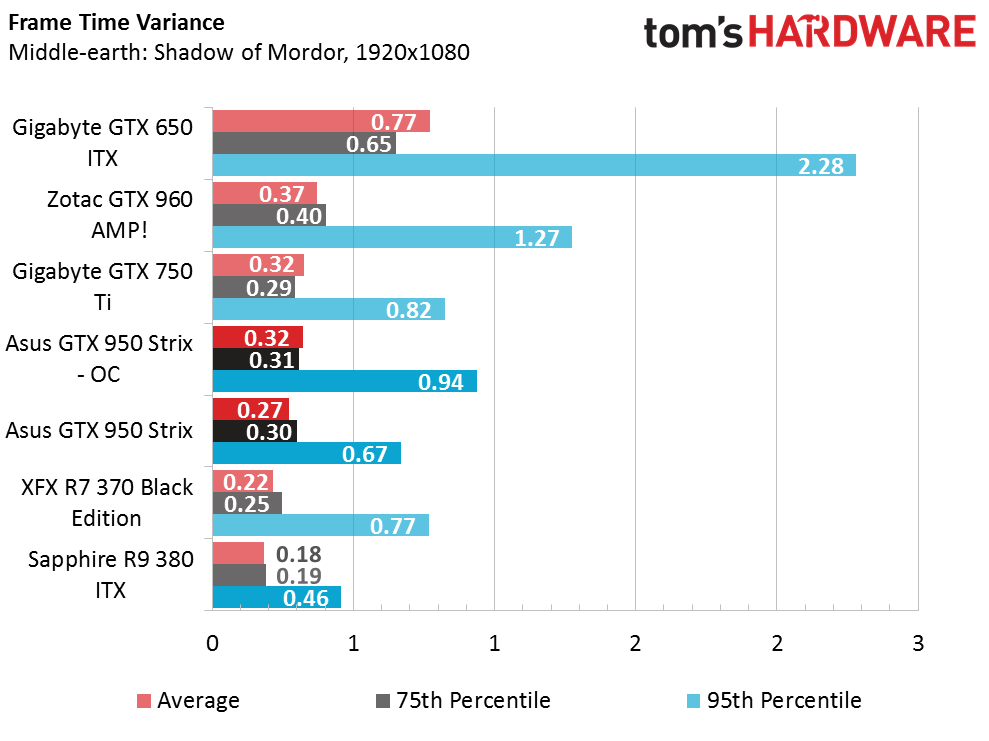
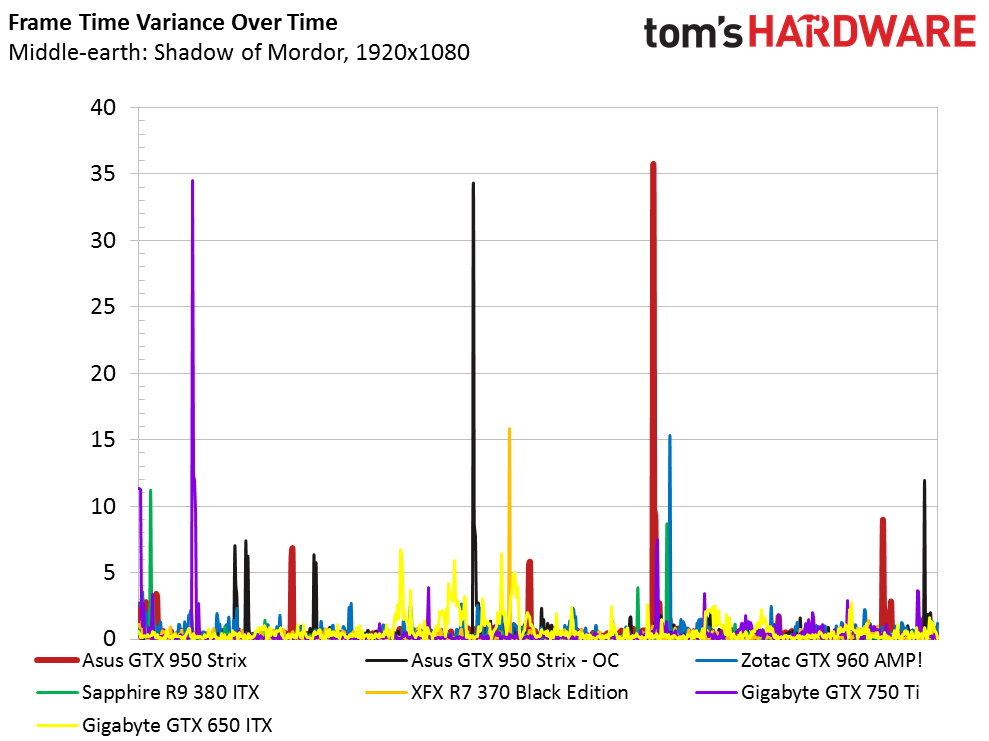
Shadow of Mordor is the other game in our benchmark suite that required altered settings (Very High, rather than the Ultra preset). This yielded performance numbers more than twice what we saw from the Ultra option.
At Very High, the Asus GTX 950 again performs well. Before overclocking, the card outpaced AMD’s R7 370 by a slight margin. And after overclocking it, the average frame rate remained above 60 FPS.
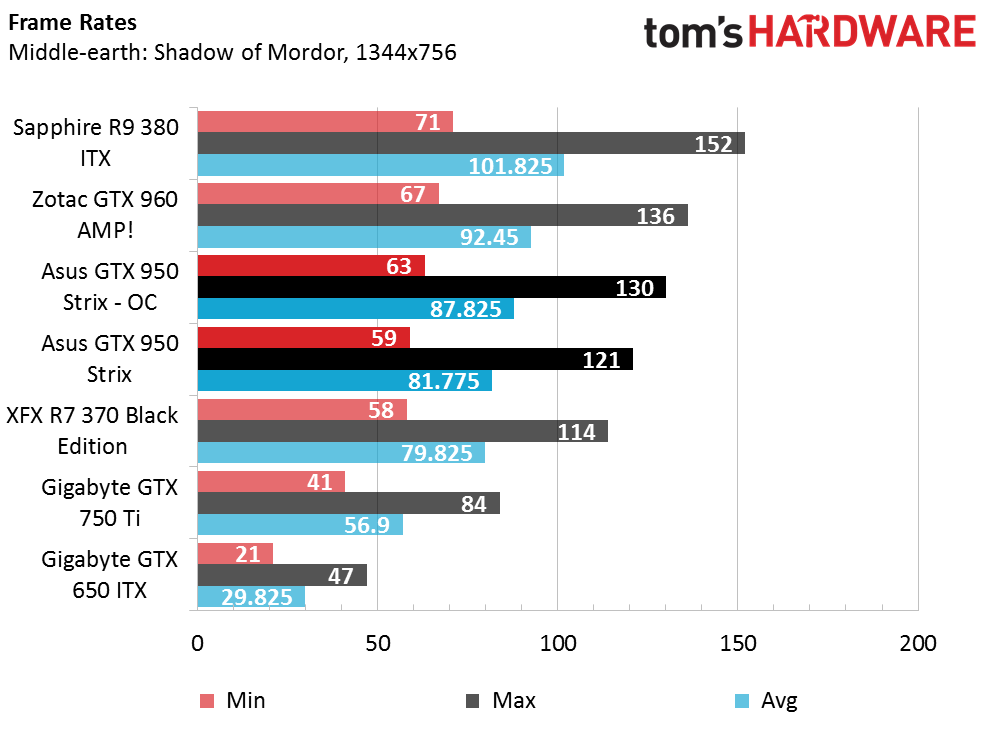
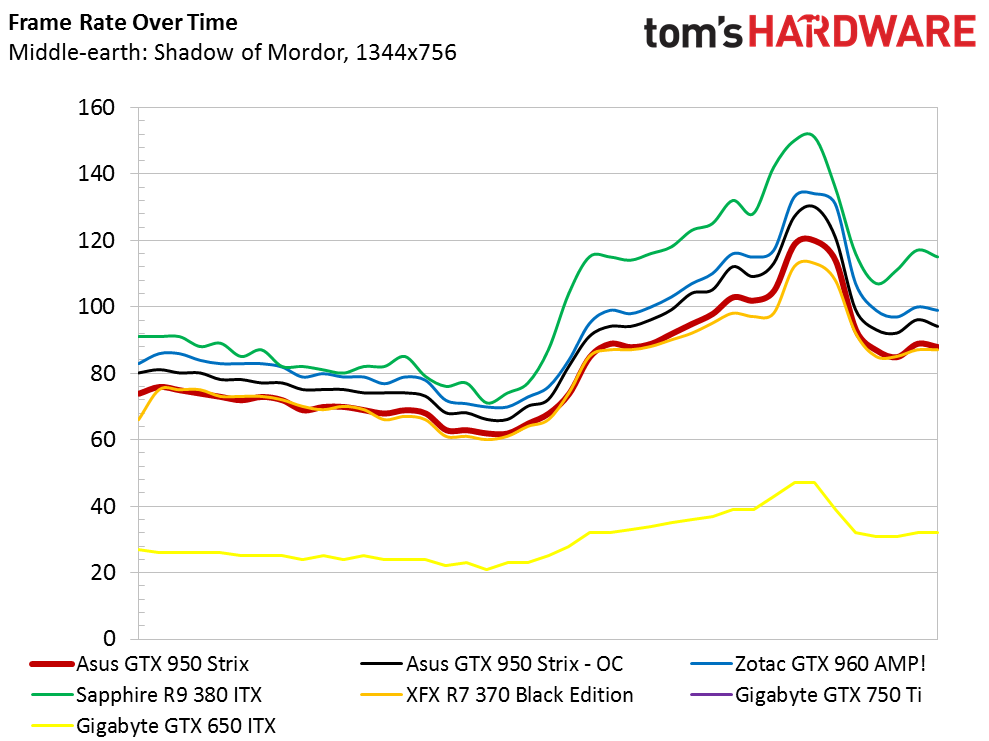
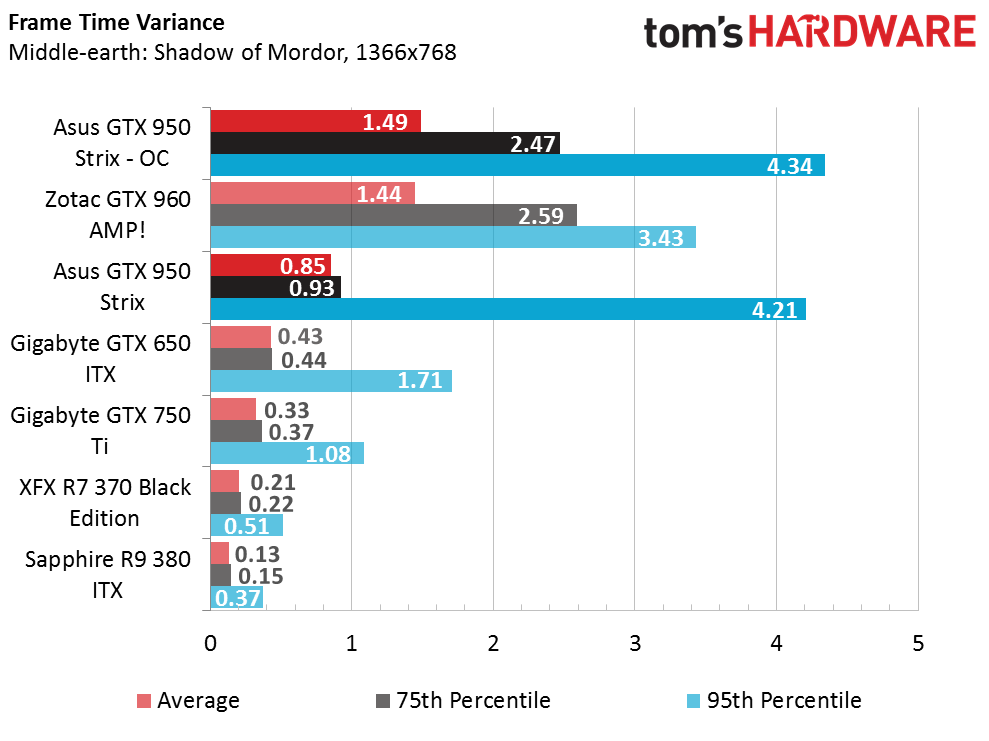
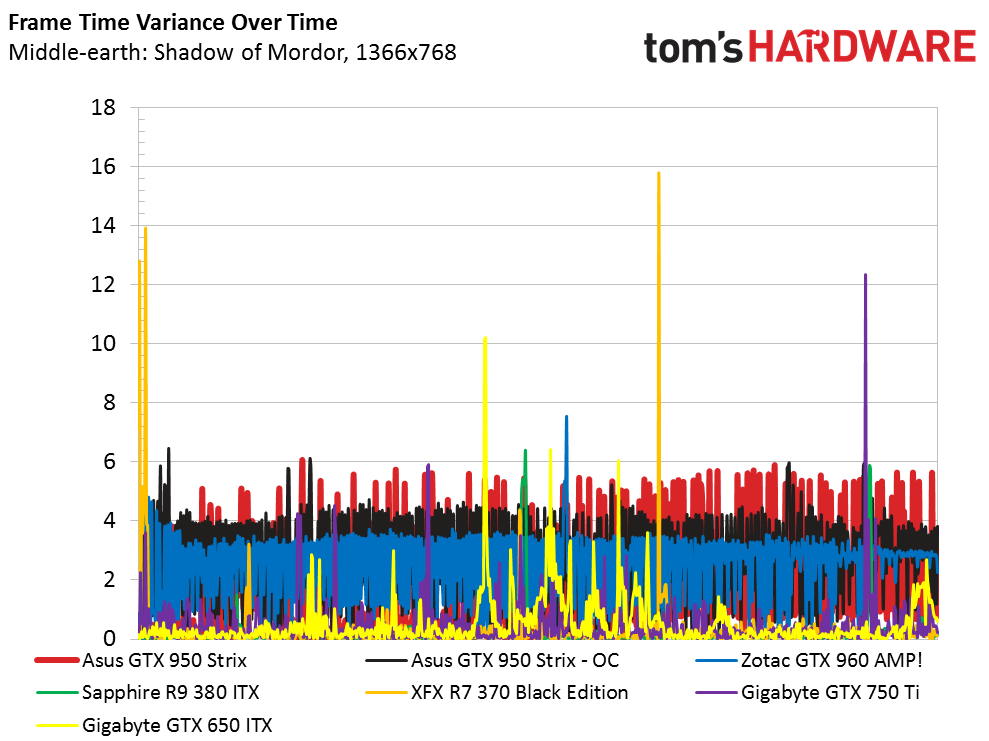
Because of the way that Shadow of Mordor scales resolution, without a 1366x768 panel, it lets you set 70% of 1080p, which ends up being 1344x756. With even fewer pixels to push, the game remains in the 60 FPS range at even its lowest point.
Tomb Raider
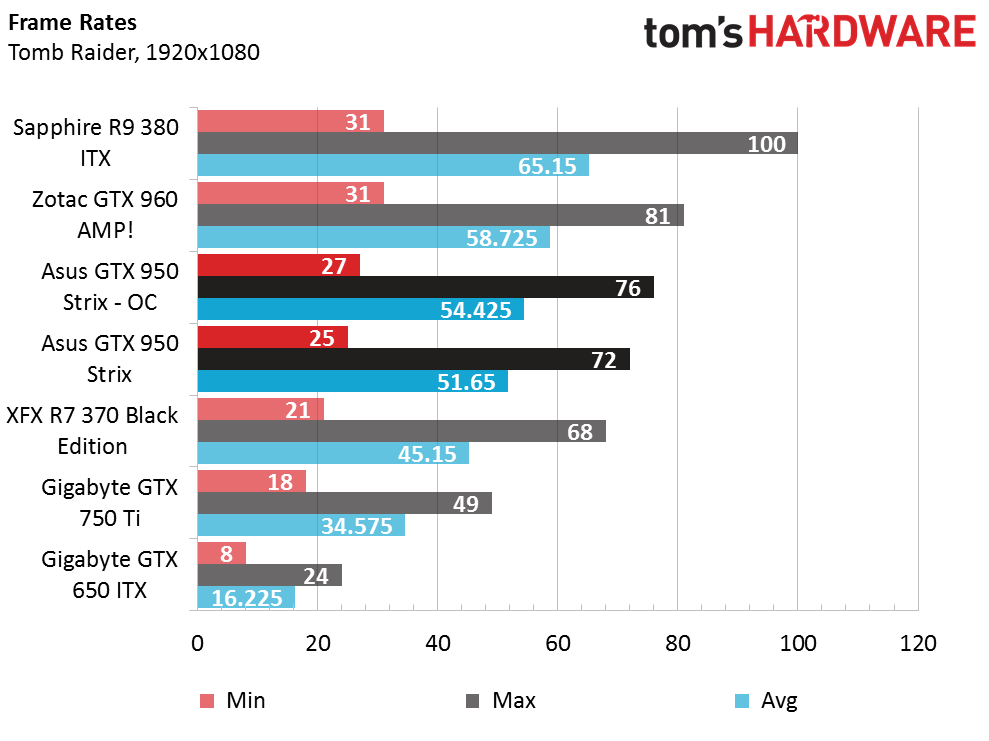
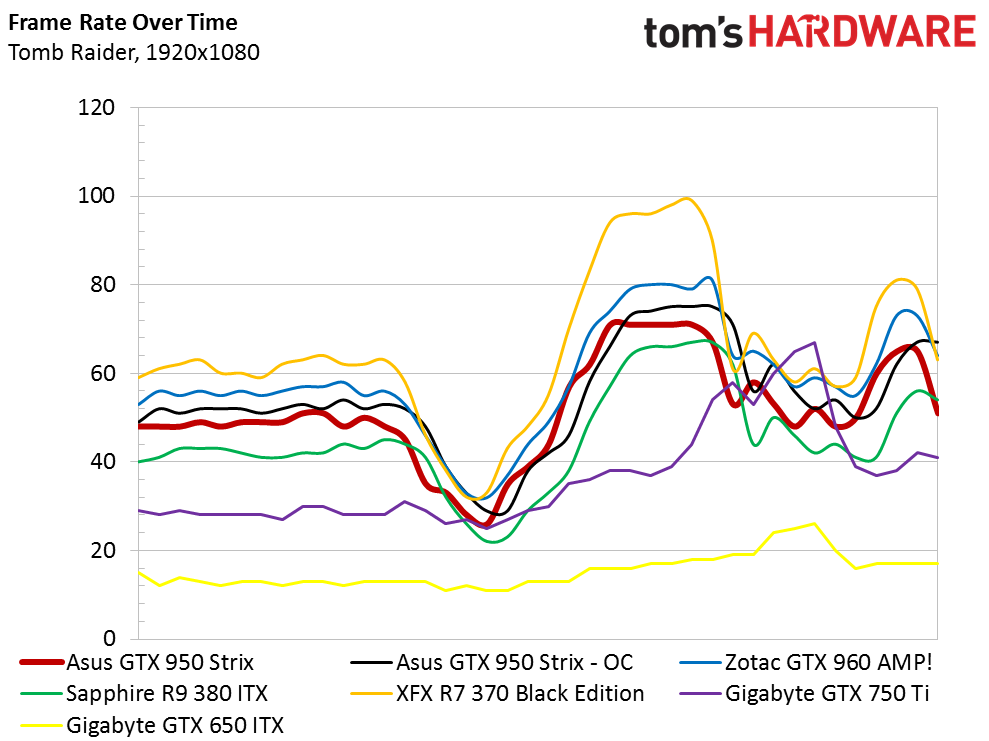
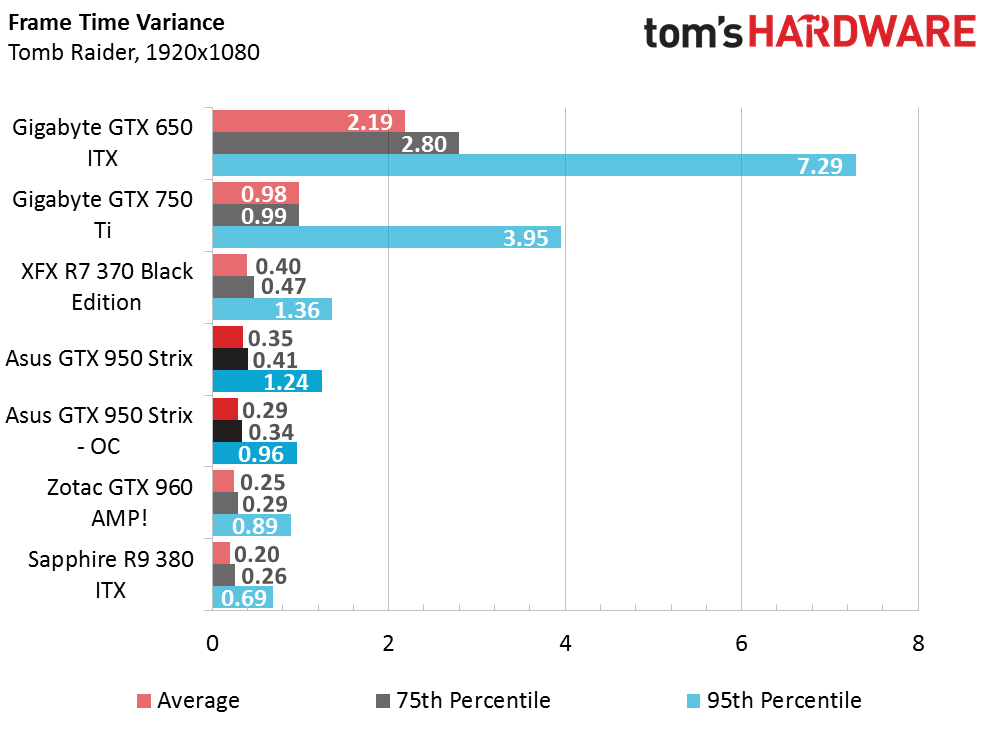
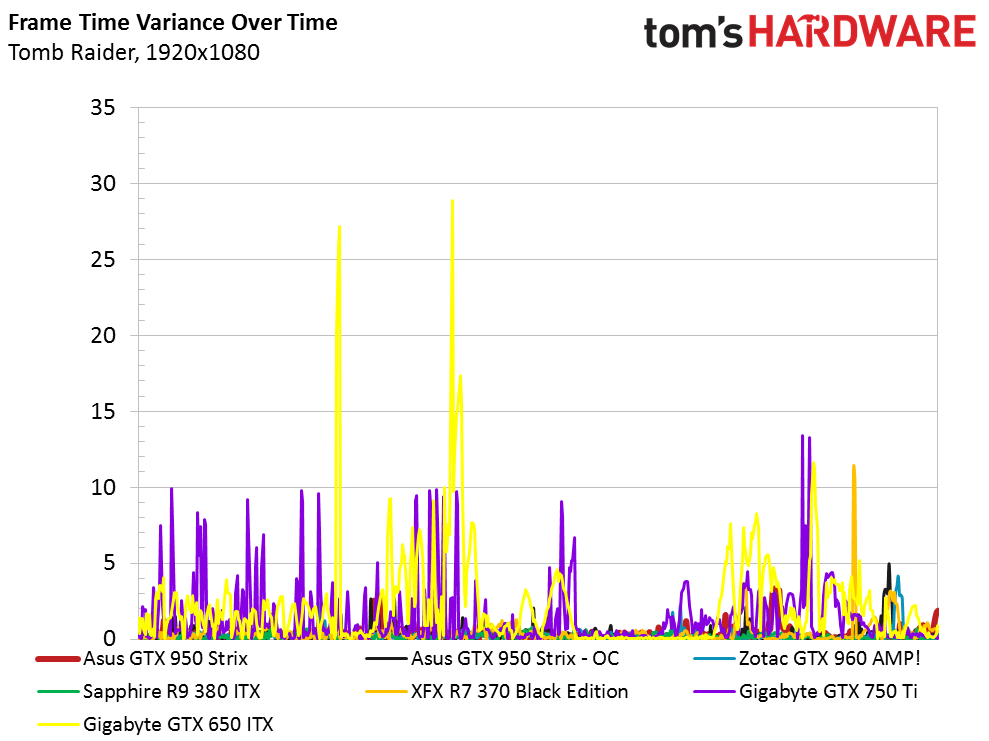
Tomb Raider was tested with maxed-out settings, but it could have used a reduction in quality for this class of GPU. While the average is within acceptable frame rates, the minimum drops way too low. A GeForce GTX 950 still delivers similar performance to the GTX 960, and again displays a significant lead over AMD’s R7 370.
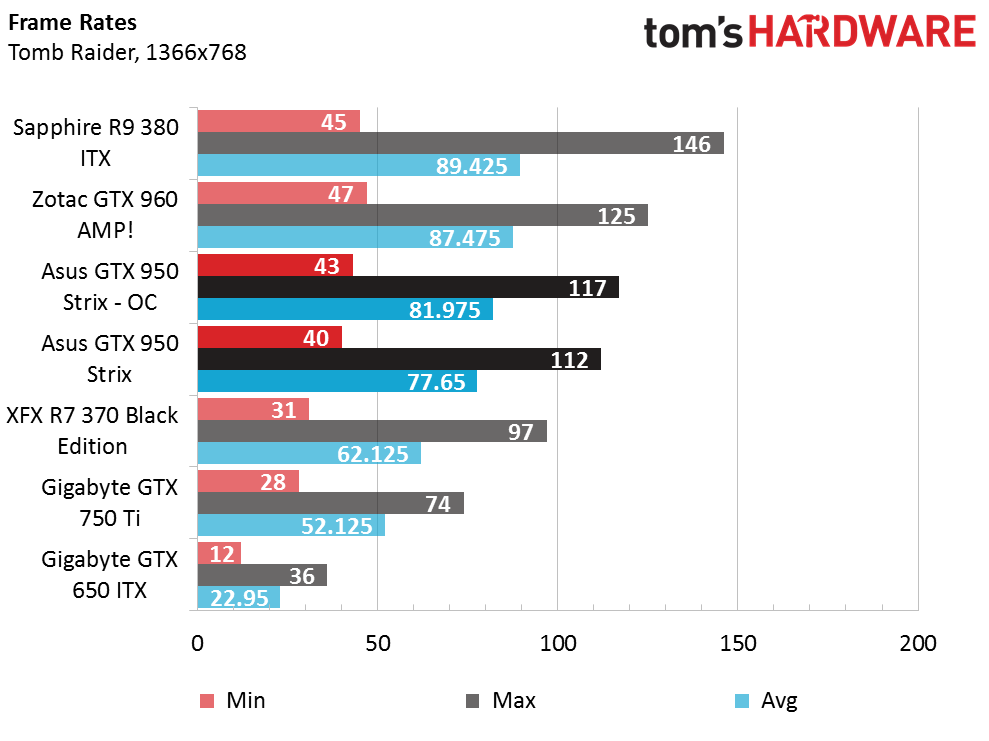
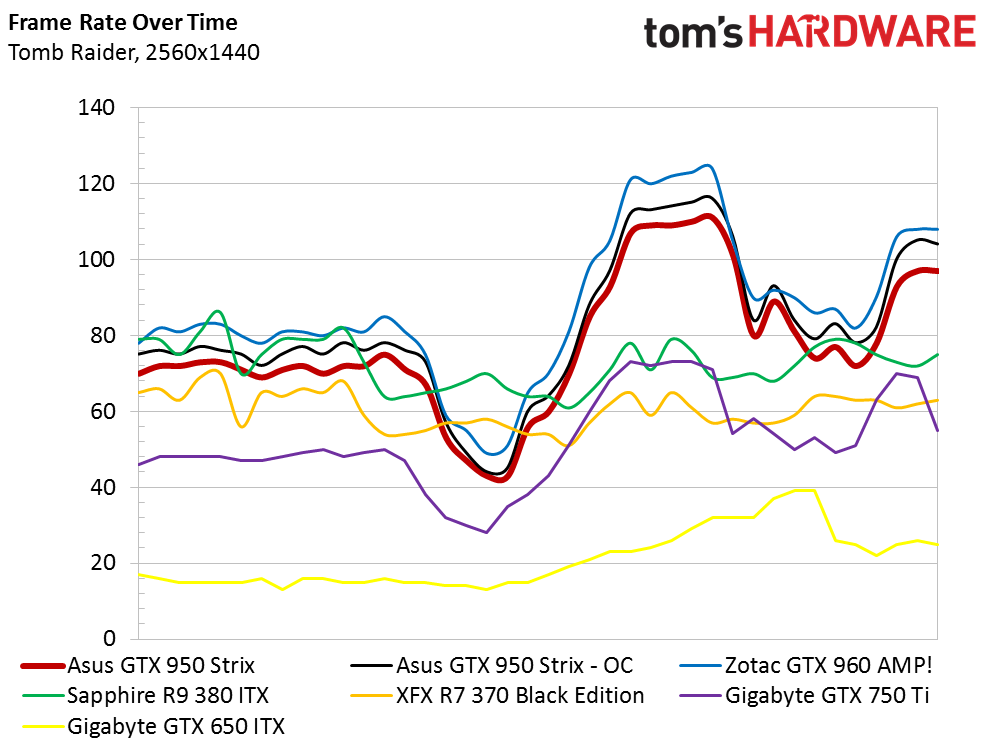
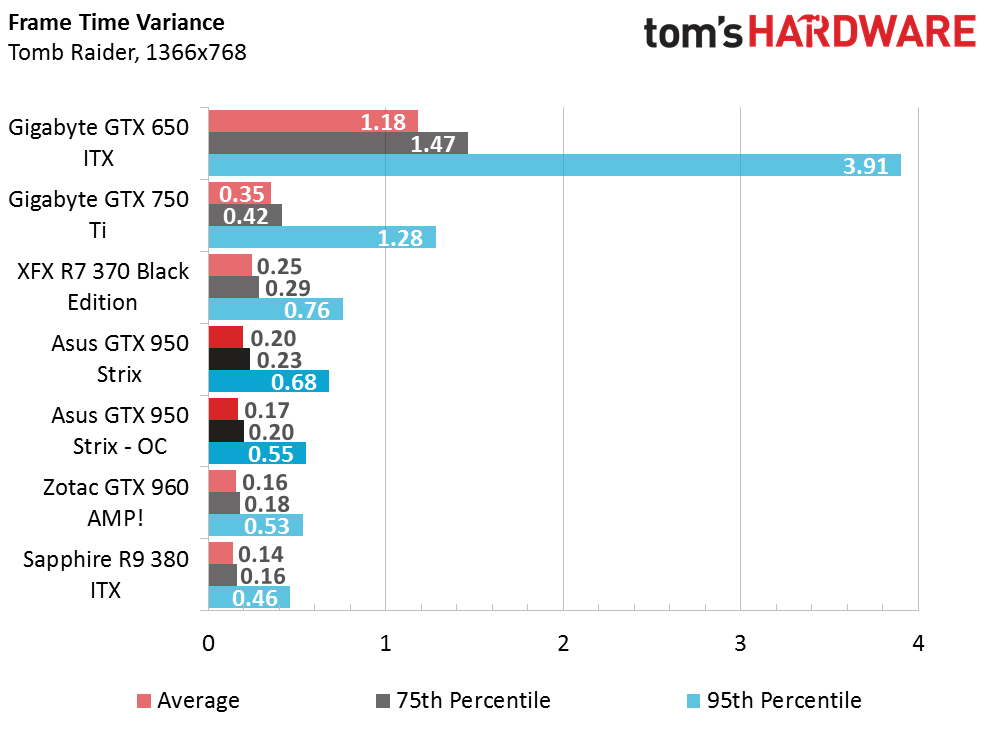
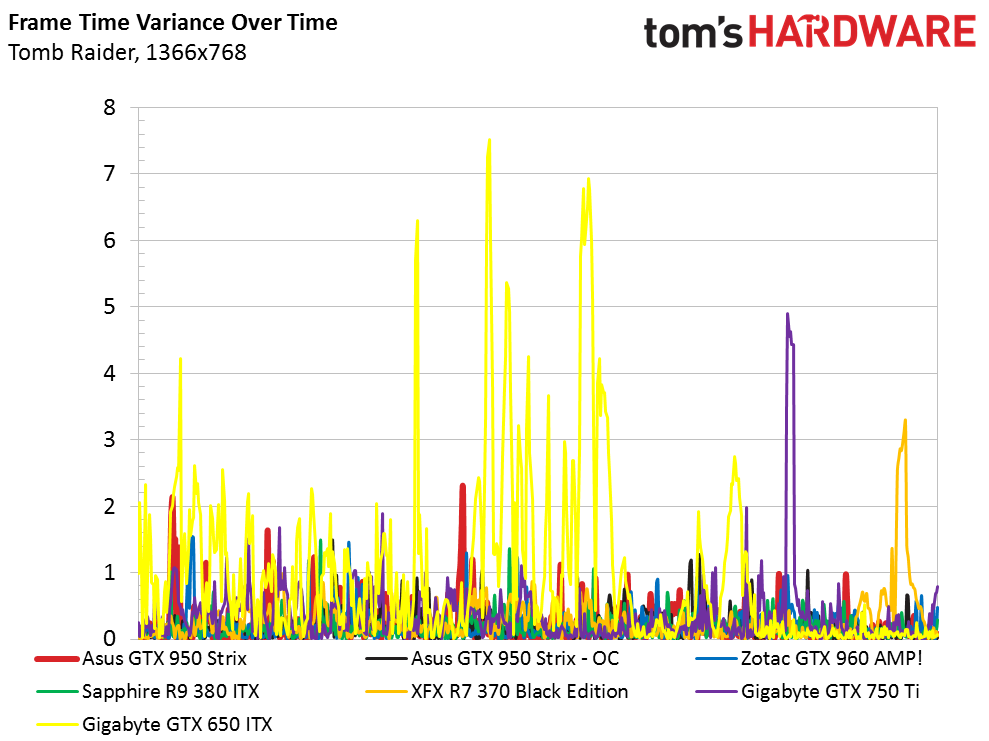
Maxed-out settings work well at the lower 1366x768 resolution, yet we still encounter drops to 40 FPS in some cases. A GTX 950 just isn’t enough to run this game at its most demanding quality levels without seeing unacceptable minimum performance results.
Kevin Carbotte is a contributing writer for Tom's Hardware who primarily covers VR and AR hardware. He has been writing for us for more than four years.
-
g-unit1111 So how does this compare in price to the GTX 960? If it's lower by about $20 - $30 I would think this card would be selling like hot cakes.Reply -
Math Geek very interesting looking card. nvidia has been doing a lot of this lately offering almost the same performance for less money than a pretty new card. it indeed looks like an awesome budget card well above the 750ti and almost as good as the 960 for a lot less.Reply
will be very interested in the other versions of this that show up. nvidia trumps amd yet again. *sigh* when will the carnage end?? please amd do something to stay relevant!!! -
Math Geek ReplySo how does this compare in price to the GTX 960? If it's lower by about $20 - $30 I would think this card would be selling like hot cakes.
article says about $160 so more like $40 less than the amp edition they compared it to. however, with prices at $175 or so on the low end it is closer to an average of $20 or so price drop. which is why he states the 960 should lose the recommendation to this card since it is almost the same performance for a less. if your goal is 1080p at decent frames according to this review there is little reason to spend the extra money on the 960 over the 950. if course this is only price speculation. once they are out, the price will drop more than likely making this even more of a good deal. -
InvalidError This might be the final nail in most of AMD's rebadged products coffins. If my HD5770 decided to die on me in the near future, I would seriously consider the GTX950.Reply -
Math Geek on the high end amd still looks ok with the new stuff but the mid to low end they are clearly not taking the nod at any price point. next gpu chart will probably be all nvidia until the very end when it might dual suggest the 390 with the 970........ maybe......Reply -
Onus I noticed some inconsistencies in the charts; sometimes the GTX750Ti is there, sometimes it isn't. To me, this is the card the GTX950 replaces, although I am disappointed it needs a 6-pin power connector.Reply
The card does look like a winner though, and reinforces a lesson I've ignored to the detriment of my wallet more than once; for a single monitor, $150-$175 is all that needs to be spent on a graphics card in order to get good settings for games.
I have to agree with the sentiment that AMD better get its tail in gear if they want to remain relevant.
-
kcarbotte ReplyI noticed some inconsistencies in the charts; sometimes the GTX750Ti is there, sometimes it isn't. To me, this is the card the GTX950 replaces, although I am disappointed it needs a 6-pin power connector.
The card does look like a winner though, and reinforces a lesson I've ignored to the detriment of my wallet more than once; for a single monitor, $150-$175 is all that needs to be spent on a graphics card in order to get good settings for games.
I have to agree with the sentiment that AMD better get its tail in gear if they want to remain relevant.
I went through the charts. Looks like the only one missing 750ti is Metro at 1080p. I've requested the image be amended. FYI: min 30, avg 39.625, max 54 on the 750ti.
Nvidia has moved the 750ti to the lower price point, but keeping it on the market.
The 950 isn't being positioned by Nvidia as an upgrade from the 750ti, as the performance isn't a big enough jump for most consumers to make the change.
It is however a notable improvement in performance over a 750ti. -
kcarbotte ReplySo how does this compare in price to the GTX 960? If it's lower by about $20 - $30 I would think this card would be selling like hot cakes.
article says about $160 so more like $40 less than the amp edition they compared it to. however, with prices at $175 or so on the low end it is closer to an average of $20 or so price drop. which is why he states the 960 should lose the recommendation to this card since it is almost the same performance for a less. if your goal is 1080p at decent frames according to this review there is little reason to spend the extra money on the 960 over the 950. if course this is only price speculation. once they are out, the price will drop more than likely making this even more of a good deal.
Bingo.
There's very little reason to get a GTX 960 over a 950 at this point in my view. The extra money, albeit only $40 or so, would be better served in a different component, or on a game.
-
logainofhades Reply16493184 said:I noticed some inconsistencies in the charts; sometimes the GTX750Ti is there, sometimes it isn't. To me, this is the card the GTX950 replaces, although I am disappointed it needs a 6-pin power connector.
The card does look like a winner though, and reinforces a lesson I've ignored to the detriment of my wallet more than once; for a single monitor, $150-$175 is all that needs to be spent on a graphics card in order to get good settings for games.
I have to agree with the sentiment that AMD better get its tail in gear if they want to remain relevant.
Maybe that card will be a 940?